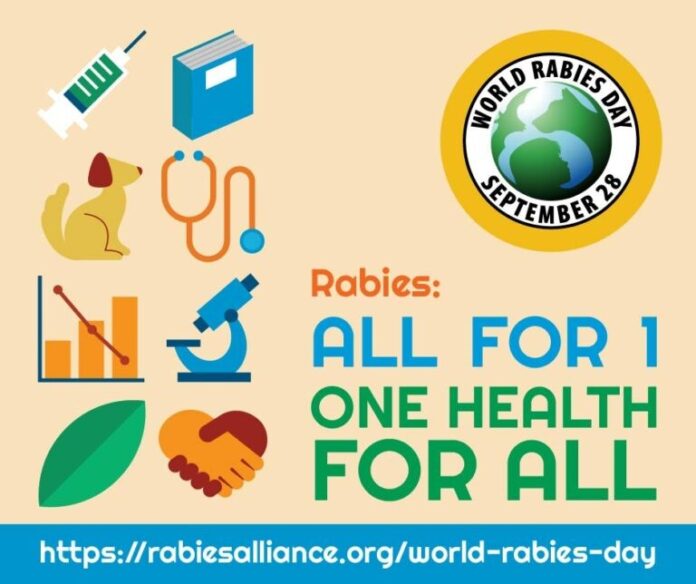RABIES – ALL FOR ONE (ONE HEALTH FOR ALL)
Dr. Shivani Mamane
Assistant Professor, Dept of Veterinary Parasitology, KVAFSU, Bidar, Karnataka
Rabies is a viral disease caused by a bullet shaped Lyssa virus. It is very important to study or know about this disease because of its of zoonotic importance i.e., this can be spread from animals to man and there is high population of stray dogs in our community. So, it is very much important to spread the awareness about rabies among the society/ children/health workers.
It is known that around 50,000 deaths around the world are caused by Rabies every year among these 40% are children under 15 years age and around 20,000 cases are reported from our country alone.
Spread of rabies
It is mainly spread by dog bite- virus present in the saliva of infected dog when comes in contact with the cut wound of contact of uninfected healthy persons or even contact of virus with mucous membrane, aerosol infections are also possible if concentration of virus is high. 97% of rabies cases are from rabid dog bite in India. The death is confirmed if the affected person shows the evident clinical signs. It takes 3 months in dogs and as less as 1 week to 2 years in humans to show the clinical signs.
Virus Pathway in infected animal:
- Virus gains entry into the body through the dog bite wound
- Encounters the nearest nerve endings and gain entry into central nervous system and reach brain
- Damage sets up in brain and then it travel to the salivary glands and get secreted in the saliva of the infected animal
- Virus from infected animal is ready to infect the healthy animal through dog bite again
Clinical signs:
In dogs two forms of rabies are found namely
- Excited form– Excessive salivation, hyperactive, attacking behavior of the infected dog, aimless running, irritated and aggressive behavior, chasing behavior, no food intake, biting of hard objects(due to presence of virus in saliva), hydrophobia, reddened congested eyes, Paralysis of throat in later stages, death occurs within 10 days of infection if above clinical signs are encountered.
- Dumb form– Affected animals prefer sitting in corner, depressed, lethargic, no food and water intake, swelling at throat region, unable to close mouth, open mouth respiration, saliva secretion
Other animals show excitement, open mouth respiration, aggressive attacking behavior, making unnatural weird sounds.
In Humans fever, headache, irritation of throat, mental imbalance, severe thirst, hydrophobia, photophobia, affected person prefers to be in a corner of dark room, excited behavior can be noticed.
Diagnosis – by looking into above clinical signs, history of dog bite, RT-PCR, FAT (gold standard test), demonstration of Negri bodies in brain cells, most of them can be confirmed after postmortem by diagnostic techniques.
Treatment – This includes post-exposure prophylaxis (PEP) consisting of immediate thorough washing of dog bite wound under running tap water with soap for straight 15 minutes, apply antiseptics like dettol and consult doctor for the vaccination. Now a days, rabies immunoglobulins are injected at the site of dog bite which have been proven to be life saving. The wound site should be made dry by exposing it to the sunlight to inactivate the virus.
Preventive measures:
- Work with the Municipal corporation to decrease the stray dog population in the society and perform ABC programmes to avoid the unnecessary dog population
- Rabies is a vaccine preventable disease so, mandatory vaccination schedule for the dog bite cases on 0, 3, 7, 14 and 28 day + TT injection proves to be most efficient strategy
- Isolation of affected animal showing the relevant clinical signs away from other animals and put it under observation for 10 days
- It becomes very much important to diagnose the condition and stop the spreading of disease any further (breaking the chain of virus)
- If encountered such cases immediately consult concerned departments, Vets for more details
- Using gloves for vets or animal handlers while dealing with any suspected o confirmed rabid cases
- Proper immunization of the domesticated animals with Anti rabies vaccine at early stage of 3 months of age and maintenance of Vaccination record book
- Celebration of World Rabies Day on September 28th of every year to create awareness for both children and adults on dog behavior
Conclusion-
A one health approach assures the engagement of multiple sectors (both medical and veterinary professionals) and local communities to build awareness and conduct mass dog vaccination campaigns. According to WHO, Rabies can significantly contribute to building of capacity of the One Health workforce. Rabies is one among the Neglected Tropical Disease which can be prevented by One Health approach. With proper vaccination and PEP we can prevent rabies and if everything goes well rabies can be eradicated from this world and make world a better place to live in.



